The Alphacool NexXxoS Cool Answer 360 DDC/XT Liquid Cooling Kit Review
by E. Fylladitakis on October 24, 2016 9:30 AM ESTInstallation
Casual users often wonder about how much harder the installation of a kit is over a AIO solution or even an air cooler. Actually, the installation itself is not very complex – the selection of the proper parts is. As the NexXxoS Cool Answer 360 DDC/XT is a full liquid cooling kit, it gives us the chance to demonstrate the installation process and highlight some of the most critical difficulties.
The first step is to install the liquid cooling block onto the CPU. Due to the size and the design of the block, this may be a very easy process, even easier than the installation of a simple air cooler. The Alphacool XP3 Light is a very easy to install block. Once the backplate with the support screws is attached to the rear of the motherboard, the block is simply fastened on the CPU using the thumbscrews and springs.
A critical issue when selecting liquid cooling parts is the selection of a proper radiator. A larger radiator will not necessarily improve performance, especially if the pump is weak and it can easily cause compatibility issues. In our case, we do have a powerful pump and the kit is configured with maximum performance and expandability in mind, so the XT45 radiator is a judicious choice.
It is however so thick that we could not fit it even in the Phantecs Enthoo Pro, a case specifically designed to support large radiators, just because the third fan was interfering with the extruding motherboard’s heatsinks. This might not have been an issue if we simply chose another motherboard with different heatsinks/layout. When selecting a high performance radiator, it is critical to take into account both the clearance of the case and the possible interference from other hardware parts.
The joined 5.25” bay reservoir and pump assembly does increase the ease of installation significantly. A stand-alone pump and reservoir would require the user to seek his/her own mounting space and methods. The placement of a reservoir in a 5.25” bay may seem very easy and straightforward, but there is a small catch; you cannot actually access the filling hole while the reservoir is inside the bay. As the reservoir needs to be pulled at least partially outside of the case, the user needs to make sure that the tubing is long enough to allow for it. For a fully clear reservoir, it is a pity that it does not have any lighting or direct support for external lighting options. This will not be an issue in a well-lit system though.
We should note that the Repack reservoir did not actually fit into the Enthoo Pro directly, as the body of the reservoir would not fit in between the side 5.25” device support tabs of the chassis. We had to bend two of the tabs out of the way in order for the reservoir to slide into a 5.25” bay. In order to effortlessly fit into any case, it should vertically have a slightly narrower body than its front faceplate, exactly like 5.25” devices do.
Once fully assembled, the liquid cooling setup looks very tidy and futuristic, having the system standing out from the appearance of a typical PC. When everything has been double-checked and tightened well (by hand, tools will damage most of these parts), it is time to fire up the PSU and fill the system with liquid. Note that the PSU needs to be disconnected from all of the system’s devices during this process, especially the motherboard. Alphacool provides a connector for the PSU that will start it without having to connect it to a motherboard, allowing to calmly fill the kit with liquid and check for leaks. Do not attempt to fill the kit with liquid by powering on the main system even if you are certain that there are no leaks because the CPU will overheat and risk damage in a matter of a few seconds without liquid into the loop.


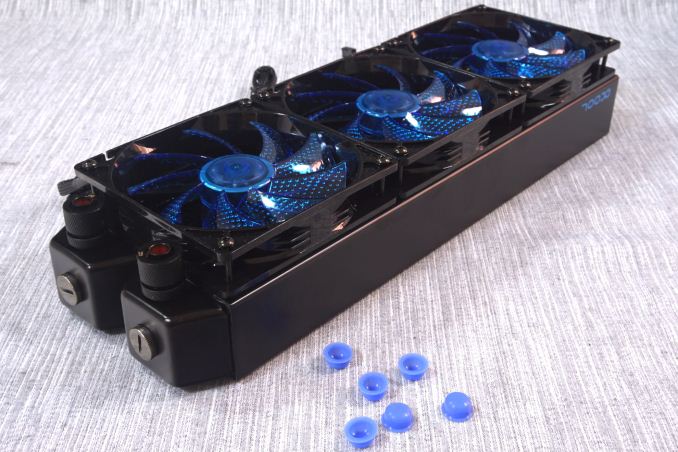
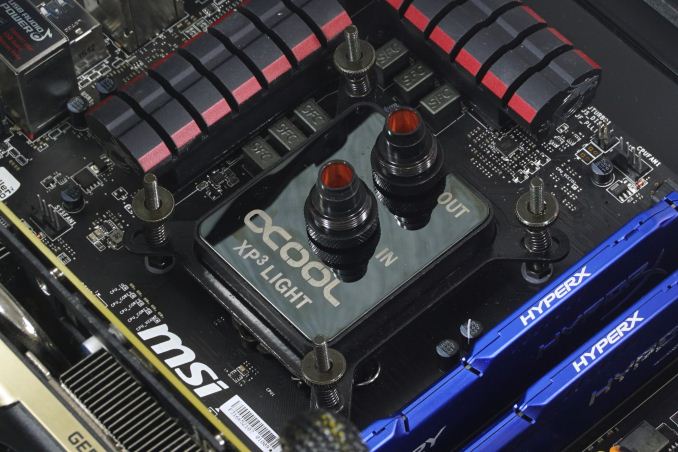
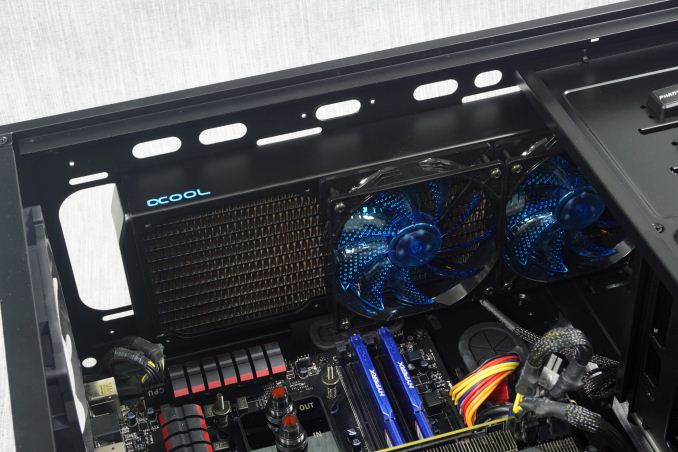
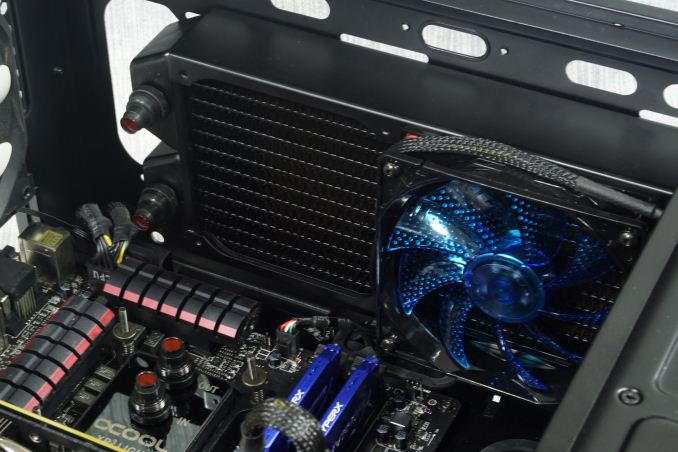
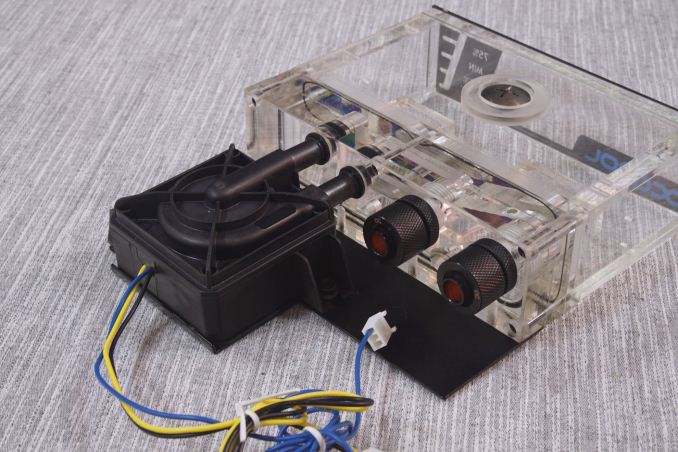
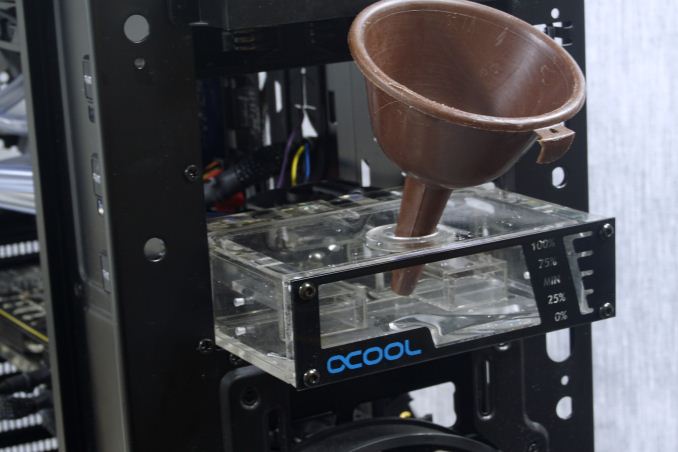









40 Comments
View All Comments
saratoga4 - Monday, October 24, 2016 - link
>copper block and a latheCopper block and mill. Lathe is the spinning one that works on pipes, mills are the drill type devices that cut blocks.
And yes, milling my first gpu cooling was pretty annoying. So much nicer these day :)
DanNeely - Monday, October 24, 2016 - link
Having used open loop coolers for the better part of a decade, I'll second that the DDC pump is going to be the loudest part if running at full speed unless you go crazy with fans. (I really wish someone would design a more suitable pump from the ground up instead of just slapping a modified top on the stock model.) However while it's picky about it's operating voltage you can slow and quiet them using PWM control. My current loop has a CPU, Mobo Mosfets, GPU, and a 560 radiator. Using an 4yo Swiftech DDC pump (not sure exact model they've got several of them) I've found that PWMing it to about 70% drops the high pitched pump noise below the noise floor of my low speed fans while only raising core temps by about 1-2C.Oxford Guy - Tuesday, November 8, 2016 - link
The pump in the EK L 2.0 kits is pretty quiet when suspended.Andrew LB - Wednesday, February 8, 2017 - link
I'm surprised they didn't use a pump like the DDC-1T PWM which is a 10w version that does 420l/h and is pretty much silent. I have one in my PC and even with an XSPC Raystorm V3 CPU block, Aquacomputer Krygraphics GTX 780ti full block, XSPC ex360 and ex280 radiators, and quite a few 90' and 45' XSPC rotary fittings, my DDC-1T PWM has a flow rate of 0.91gpm according to my Aquacomputer Aquaero with high-flow meter.Aerodrifting - Monday, October 24, 2016 - link
The part which the pump connects to the reservoir really concerns me. From the looks of it, It's just the barbs that come with DDC stock top (which we usually replace with custom ones to fit standard fittings plus better flow) go straight into the opening of the reservoir without any tightening measures. Are you sure that is not going to leak?BrokenCrayons - Monday, October 24, 2016 - link
The benchmark results are pretty impressive, but hardly worth the risk of mixing liquid with electricity or the added cost over just using the manufactuerer certified heatsink and fan that comes in the box with the CPU. So the processor runs at 40 degrees instead of 70. That's utterly meaningless to me when the max temp for a chip is typically +90 degrees and certainly not worth any additional cost at all much less a cost that includes the problem of pumping fluids around a system that works perfectly well with circulating air.Death666Angel - Monday, October 24, 2016 - link
It's a hobby. It can have some benefits, but it's a hobby first and foremost in my opinion. Yes, I could overclock my CPU and GPU some more while under water, it has a bit less noise and it can be more versatile. But modern aircooling is also pretty good, usually cheaper and not that much louder if you select good components. Though I will always spend a bit more to get a better cooler compared to the boxed offerings (headroom in the summer, dust buildup, better overclocking, quieter operations). But it depends on your setup and taste. :)BrokenCrayons - Monday, October 24, 2016 - link
That I can understand. Everyone has something they waste time and money on just for fun, but I don't think there's a practical reason behind it. I leave my desktop computer with it's 95W 860K CPU sitting in the mud room (no AC...basically my front porch) and run it headlessly to stream games. It spent the summer in ambient temps of around 80-85 degrees streaming games via Steam and the entire time it was and still is on the pre-Wraith HSF that came in the box with the CPU.Sure, I thought about replacing the cooler with something non-OEM or even getting a Wraith second hand from ebay or something, but there's absolutely no reason to do so. I can't rationalize spending even a minimal amount of money on it and then going through the trouble of opening the case up to replace the HSF. I might clean the dust bunnies out next spring, but at this point any additional cooling would serve no practical purpose.
letmepicyou - Monday, October 24, 2016 - link
There is a VERY practical purpose to water cooling which you're missing. If you've ever used a high end air cooler (and I have a cupboard full of them, up to the top shelf Thermalright Silver Arrow) then you know that they're HEAVY. This isn't a problem if your computer sits at your desk until cleaning time or your next upgrade cycle. I can promise you that having a huge cooler on your motherboard can be precarious if you tend to lug your PC around at all. You have to be pretty ginger with your movements.The reason I went to water cooling is now when I lug my PC around, I don't have to worry about component stresses. Given that I have a nice AIO loop on my CPU and run all SSDs, I could boot kick my tower and not worry about data loss or yanking the mounting post for my air cooler through the fiberglass of my motherboard.
BrokenCrayons - Tuesday, October 25, 2016 - link
Actually, my argument is in favor of OEM-boxed coolers that ship in retail packaging with the CPU. Those have never been too heavy for the mounting mechanisms that support them. The situation of an overweight air cooler is a self-inflicted wound that wouldn't have required the proverbial medical attention of liquid cooling had the person in question never picked up the overweight air cooler knife to begin with.